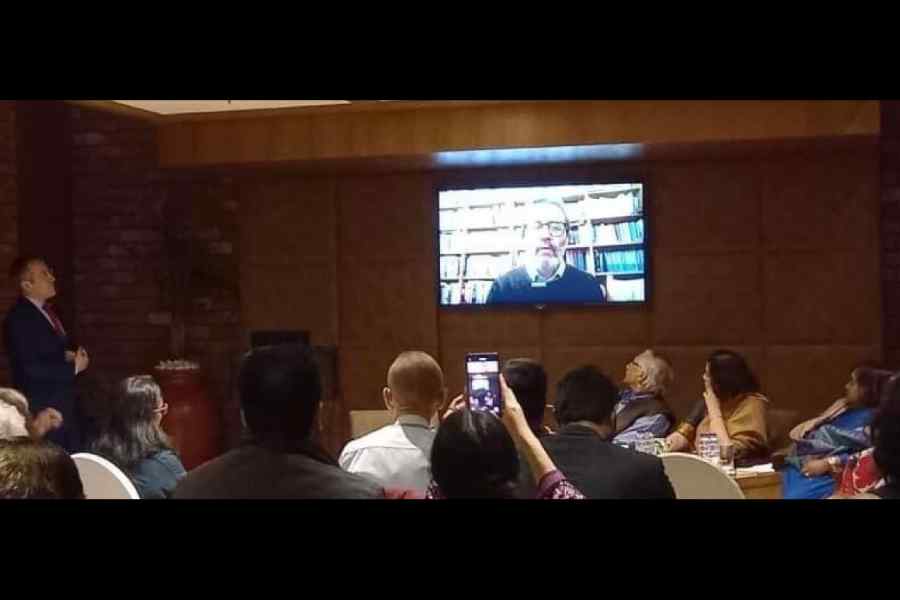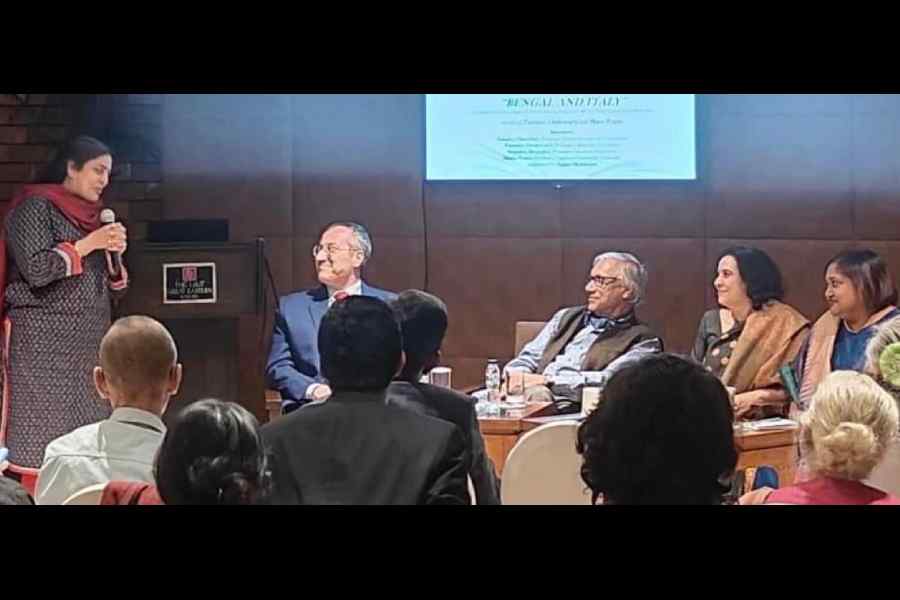The relations between Kolkata and Italy were defined not just by Firpo or Peliti but by a whole gamut of writers, thinkers, authors and artistes who formed “bridges between Bengal and Italy”.
In the fourth edition of the Italo-Kolkatan Heritage Conversations, a book titled Bengal and Italy: Transcultural Encounters from the Mid-19th to the Early 21st Century was launched on Friday.
Speaking virtually, Mario Prayer, co-editor of the book and professor at Sapienza University in Rome, said: “This book is a result of a project funded by the Sapienza University in collaboration with Jadavpur University.”
Sukanta Chaudhuri, professor emeritus, Jadavpur University, whose essay, From Dante to Rabindranath: An Unfolding Renaissance, is the opening chapter of the book, spoke of the primacy of the role of Italy in shaping the Bengal Renaissance.

Professor Mario Prayer addressing the audience at the book launch of Bengal and Italy : Transcultural Encounters from the mid-19th Century to the Early 21st Century on December 28 at the Lalit Great Eastern Hotel Sourced by The Telegraph
“Actual interaction with Italian models, particularly through the Italian language, was limited. Students of Hindu College read English translations of Italian classics of the Renaissance. But there is one exceptional person who did interact closely with the Italian language and literature. That was Michael Madhusudan Dutt, who brought into the Bengali language not just the form of the sonnet but also many other literary practices and literary models from Dante, from Tasso.”
As an anecdote, Chaudhuri added that Dutt had written a sonnet about Dante and sent it to the then king of united Italy. The king’s secretary thanked him.
In popular culture, the two most popular Italian names associated with Kolkata are Firpo and Peliti. Firpo’s, the marquee restaurant on Chowringhee, was established by a man from Genoa, Angelo Firpo, after World War I.
Peliti’s, an Italian bakery nearby, was established by Federico Peliti in the 1870s.
Both eateries were patronised by the well-heeled European gentry and the native royalty.
Prayer, who has an essay in the book on Bengali internationalists in inter-war Italy, spoke of Surendranath Dasgupta, Benoy Kumar Sarkar, Kalidas Nag and others. “Going back to the early 20th century, we find Benedetti Croce come in touch with the Indian historian of philosophy Surendranath Dasgupta. In one of his essays, Dasgupta related Croce’s ideas to those of Buddhism.”
In 1936, Dasgupta received an honorary degree from Sapienza University, said Prayer.
In her essay, co-editor Paromita Chakravarty, professor of English at Jadavpur University, shows how group theatre practitioners used Italian plays to make definitive statements and bring in new political positionings and aesthetics.
“I found that at crucial stages of the group theatre movement, the catalysing element has been Italian drama, both in terms of form and content and also in terms of politics, ideology, tone and tenor. For instance, when Nandikar is taking shape and is breaking away from IPTA, Rudraprasad Sengupta uses Pirandello to help establish Nandikar’s reputation,” she said.
Bibhash Chakravarti chose Dario Fo’s play Trumpets and Raspberries, which he adapted as Hochhe Ta Ki as the inaugural play of his group, Anya Theatre.
Paromita Chakravarty mentioned the coming in of women directors like Tripti Mitra, Saonli Mitra, Usha Ganguly and Sohag Sen as a turning point in group theatre that brought in feminist themes. This new interest in gender politics was manifested through adaptations of Franca Rame’s plays.
Sanjukta Dasgupta, associate professor at Sapienza University, looked at travel writings by Bengali travellers to Italy.
She said Italy was the first port of call for most of the travellers to Europe. She divides them into the pre-World War I and post-World War I travellers, limiting her study to the colonial period.
“The travellers were largely on their way to England to study or sit for the ICS. It was also a sort of pilgrimage for the English-educated elite Bengalis because it was the West, it was modernity and progress towards which they aspired,” she said.
Travellers to Italy after World War I were not simply tourists or passers-by. “They lived in Italy for a longer period and, as inside outsiders, were deeply engaged with contemporary Italian politics and literature,” she said.
The book also has an essay by art historian Rituparna Basu who looks at Italian artist Olinto Ghilardi, who briefly served as vice-principal of Calcutta Art School, and Sashi Kumar Hesh, an Indian artist who studied on a scholarship in Italy.
As a post-script, Italian consul-general Gianluca Rubagotti spoke about continuing Calcutta-Italy collaborations.
